The second-life battery storage systems market is projected to grow from USD 608.5 million in 2025 to USD 1,163.8 million by 2035, representing a CAGR of 6.7%. Year-on-year growth fluctuations can be closely correlated with shifts in industrial adoption, regulatory incentives, and consumer energy preferences. Initial spikes in growth are linked to increased incorporation of electric vehicle batteries into stationary storage solutions, where policy frameworks supporting renewable integration and grid efficiency accelerate uptake.
Mid-period growth reflects broader deployment in commercial and residential energy storage, influenced by evolving energy pricing models, demand response programs, and cost-competitiveness of repurposed battery systems. Consumer preference for decentralized energy solutions and the gradual shift toward circular economy models contribute to expanding adoption, highlighting how industry drivers directly influence market expansion and provide revenue momentum for second-life battery storage providers.
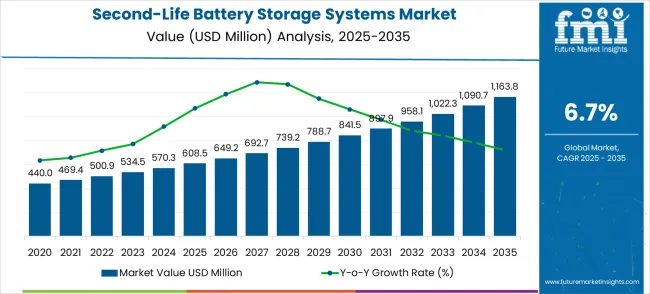
The market trajectory demonstrates that YoY spikes are often driven by tangible industry actions and policy implementation, rather than purely technological factors. Growth acceleration is observed when incentives or subsidies encourage utility-scale projects and commercial installations, reinforcing the importance of regulatory support in the market. Peaks also align with strategic collaborations between battery manufacturers, energy storage integrators, and grid operators, which enable scale and reduce deployment risks. In addition, fluctuating raw material prices and the cost advantages of reusing EV batteries create a pattern of growth that, while steady, reflects adaptive market behavior. This interplay of policy, consumer preference, and operational efficiency ensures that second-life battery storage systems remain a critical component of modern energy infrastructure, with revenue potential tied closely to tangible adoption trends across the decade.
| Metric | Value |
|---|---|
| Market Value (2025) | USD 608.5 million |
| Market Forecast Value (2035) | USD 1,163.8 million |
| Market Forecast CAGR | 6.7% |
The second-life battery storage systems market holds a notable presence across multiple parent markets, demonstrating its utility in energy management and vehicle battery repurposing. Within the energy storage systems market, it contributes approximately 10% of the share, being adopted for peak load balancing and backup applications. In the electric vehicle battery market, the share is around 12%, reflecting the reuse of retired EV batteries in stationary storage solutions. The renewable energy integration market accounts for about 8% share, where second-life batteries support intermittent generation from solar and wind installations. In the grid management and stabilization market, the market holds roughly 6%, emphasizing its role in frequency regulation and load leveling. Finally, in the industrial and commercial energy solutions market, the share is estimated at 7%, where these batteries provide cost-effective energy storage for factories and commercial buildings. Collectively, these percentages highlight the growing importance of second-life battery storage systems in optimizing energy efficiency and extending battery lifecycle across diverse sectors.
Market expansion is being supported by the rapid increase in electric vehicle adoption worldwide and the corresponding need for sustainable battery disposal solutions that provide cost-effective energy storage capabilities and environmental sustainability for renewable energy applications. Modern energy storage facilities rely on consistent performance and cost efficiency to ensure optimal grid stabilization including utility-scale installations, commercial energy systems, and residential storage facilities. Even minor performance inefficiencies can require comprehensive system adjustments to maintain optimal energy storage standards and grid stability performance.
The growing complexity of energy storage requirements and increasing demand for sustainable battery solutions are driving demand for second-life battery storage systems from certified manufacturers with appropriate recycling capabilities and technical expertise. Energy storage operators are increasingly requiring documented sustainability credentials and performance reliability to maintain grid stability and operational efficiency. Industry specifications and sustainability standards are establishing standardized battery recycling procedures that require specialized second-life technologies and trained energy storage personnel.
The Second-Life Battery Storage Systems market is entering a new phase of growth, driven by demand for sustainable energy storage, renewable energy expansion, and evolving environmental and cost optimization standards. By 2035, these pathways together can unlock USD 200-250 million in incremental revenue opportunities beyond baseline growth.
Pathway A -- Reliable Chemistry Leadership (LFP Battery Systems) The LFP segment already holds the largest share due to its stability and safety characteristics. Expanding performance optimization, refurbishment innovation, and safety validation can consolidate leadership. Opportunity pool: USD 60-80 million.
Pathway B -- Grid-Scale Applications (Utility & Commercial Storage) Utility-scale applications account for the largest demand. Growing renewable energy infrastructure, especially in emerging economies, will drive higher adoption of second-life battery storage systems. Opportunity pool: USD 50-65 million.
Pathway C -- Advanced Chemistry Systems (NMC & Hybrid Technologies) High-performance chemistries are expanding with increasing focus on energy density and grid integration. Systems optimized for demanding applications can capture premium segments. Opportunity pool: USD 30-40 million.
Pathway D -- Emerging Market Expansion Asia-Pacific and Latin America present growing demand due to rising renewable energy infrastructure. Targeting energy storage networks and cost-competitive solutions will accelerate adoption. Opportunity pool: USD 25-35 million.
Pathway E -- Residential & Distributed Storage With increasing residential solar adoption, there is an opportunity to promote second-life systems optimized for home energy storage applications. Opportunity pool: USD 15-20 million.
Pathway F -- Specialized Applications (Microgrid & Industrial) Systems optimized for microgrids, industrial energy storage, and specialized applications offer premium positioning for high-reliability sectors. Opportunity pool: USD 10-15 million.
Pathway G -- Refurbishment Services & Lifecycle Management Recurring revenue from battery testing, refurbishment services, and lifecycle management creates long-term value streams. Opportunity pool: USD 8-12 million.
Pathway H -- Digital Integration & Smart Grid Connectivity Digital energy management, grid integration, and smart monitoring can elevate systems into "intelligent energy storage" categories. Opportunity pool: USD 5-8 million.
The market is segmented by battery chemistry, application, and region. By battery chemistry, the market is divided into Lithium Iron Phosphate (LFP), Nickel Manganese Cobalt (NMC), Nickel Cobalt Aluminum (NCA), and hybrid second-life systems. Based on application, the market is categorized into residential, commercial, and utility-scale energy storage systems. Regionally, the market is divided into North America, Europe, East Asia, South Asia & Pacific, Latin America, and Middle East & Africa.
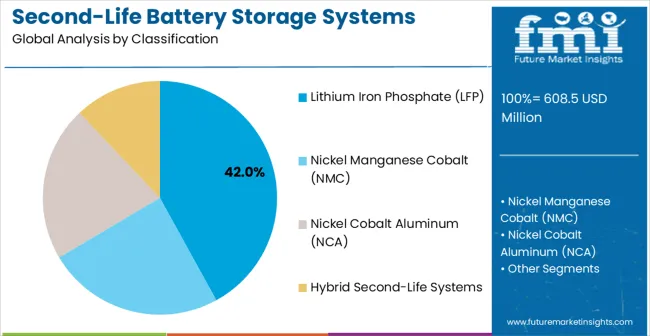
In 2025, the Lithium Iron Phosphate (LFP) second-life battery storage systems segment is projected to capture around 42% of the total market share, making it the leading battery chemistry category. This dominance is largely driven by the widespread adoption of stable and long-lasting battery technologies that provide optimal balance between performance reliability and safety characteristics, catering to a wide variety of energy storage applications. LFP batteries are particularly favored for their ability to deliver consistent energy storage performance in both grid-scale and distributed energy storage installations, ensuring operational reliability and extended service life.
Utility companies, commercial energy providers, renewable energy facilities, and residential storage systems increasingly prefer this chemistry, as it meets energy storage needs without imposing excessive safety concerns or performance degradation issues. The availability of well-established refurbishment processes, along with comprehensive safety testing options and performance validation from leading recycling companies, further reinforces the segment's market position. Additionally, this chemistry category benefits from consistent demand across regions, as it is considered a practical and safe solution for facilities requiring reliable second-life energy storage and operational longevity. The combination of safety reliability, performance consistency, and cost-effectiveness makes LFP second-life battery storage systems a dependable choice, ensuring their continued popularity in the sustainable energy storage and battery recycling markets.
The utility-scale segment is expected to represent 48% of second-life battery storage systems demand in 2025, highlighting its position as the most significant application sector. This dominance stems from the essential energy storage requirements of large-scale power grid environments, where cost-effective storage solutions and grid stabilization capabilities are critical to renewable energy integration and power system reliability. Utility-scale applications often feature extensive energy storage requirements that demand specialized second-life battery systems throughout large-scale energy installations, requiring reliable and cost-effective storage solutions. Second-life battery storage systems are particularly well-suited to these environments due to their ability to provide consistent energy storage capacity at reduced costs, even during variable renewable energy generation and fluctuating grid demands.
As renewable energy systems expand globally and emphasize improved grid integration, the demand for second-life battery storage systems continues to rise. The segment also benefits from heightened sustainability requirements within the energy industry, where operators are increasingly prioritizing circular economy principles and cost optimization as essential operational measures. With utility companies investing in renewable energy infrastructure and grid modernization standards, second-life battery storage systems provide an essential solution to maintain cost-effective grid-scale energy storage. The growth of solar and wind energy installations, coupled with increased focus on grid stability and energy security, ensures that utility-scale applications will remain the largest and most stable demand driver for second-life battery storage systems in the forecast period.
The Second-Life Battery Storage Systems market is advancing rapidly due to increasing electric vehicle adoption and growing recognition of battery recycling advantages over disposal alternatives in sustainable energy storage applications. However, the market faces challenges including performance degradation concerns compared to new batteries, complex testing and certification requirements for recycled systems, and varying regulations for second-life battery applications across different energy storage regions. Performance validation efforts and advanced refurbishment technology programs continue to influence equipment development and market adoption patterns.
The growing development of advanced battery testing and refurbishment systems is enabling higher performance reliability with improved safety validation and enhanced energy storage capabilities. Advanced refurbishment technologies and optimized battery management systems provide superior second-life performance while maintaining safety compliance requirements. These technologies are particularly valuable for energy storage operators who require reliable storage performance that can support extensive grid stabilization operations with consistent energy results.
Modern second-life battery storage system manufacturers are incorporating advanced sustainability principles and lifecycle management systems that enhance environmental performance and operational effectiveness. Integration of comprehensive recycling programs and optimized battery lifecycle management enables superior sustainability performance and comprehensive environmental stewardship capabilities. Advanced sustainability features support operation in diverse energy storage environments while meeting various environmental requirements and regulatory specifications.
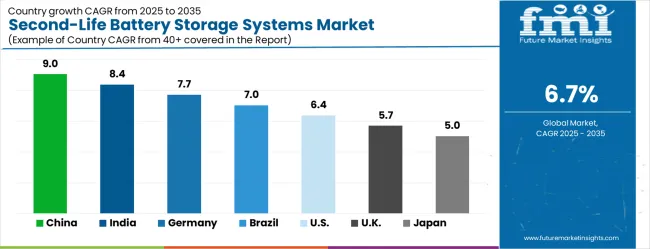
| Country | CAGR (2025-2035) |
|---|---|
| China | 9% |
| India | 8.4% |
| Germany | 7.7% |
| Brazil | 7% |
| United States | 6.4% |
| United Kingdom | 5.7% |
| Japan | 5% |
The second-life battery storage systems market is growing rapidly, with China leading at a 9% CAGR through 2035, driven by massive electric vehicle adoption and increasing focus on battery recycling and sustainable energy storage technologies. India follows at 8.4%, supported by rising renewable energy infrastructure development and growing awareness of circular economy principles in energy storage. Germany grows strongly at 7.7%, integrating advanced battery recycling technology into its established renewable energy infrastructure. Brazil records 7%, emphasizing sustainable energy modernization and circular economy initiatives. The United States shows solid growth at 6.4%, focusing on grid modernization and renewable energy integration. The United Kingdom demonstrates steady progress at 5.7%, maintaining established sustainability applications. Japan records 5% growth, concentrating on technology advancement and circular economy optimization.
The report covers an in-depth analysis of 40+ countries; seven top-performing countries are highlighted below.
The second-life battery storage systems market in China is projected to exhibit the highest growth rate with a CAGR of 9% through 2035, driven by unprecedented expansion of electric vehicle production and increasing demand for sustainable energy storage solutions. The country's massive EV manufacturing sector and expanding renewable energy facilities are creating enormous supply of retired batteries suitable for second-life applications. Major energy companies are establishing comprehensive battery recycling networks to support the increasing requirements of utility operators and renewable energy facilities across grid regions.
Government circular economy development initiatives are supporting establishment of sustainable energy storage facilities and battery recycling complexes, driving demand for second-life storage systems throughout major renewable energy zones. Sustainability sector modernization programs are facilitating adoption of circular economy technologies that enhance energy storage efficiency and environmental compliance standards across energy networks.
The second-life battery storage systems market in India is expanding at a CAGR of 8.4%, supported by increasing renewable energy sector development and growing awareness of sustainable energy storage benefits. The country's expanding solar and wind energy infrastructure and rising energy storage requirements are driving demand for cost-effective storage solutions. Energy companies and utility providers are gradually implementing second-life battery systems to maintain competitive storage costs and environmental performance.
Renewable energy sector growth and sustainability infrastructure development are creating opportunities for suppliers that can support diverse energy storage requirements and environmental specifications. Professional training and technical programs are building expertise among energy storage personnel, enabling effective utilization of second-life battery technology that meets renewable energy standards and grid stability requirements.
The second-life battery storage systems market in Germany is projected to grow at a CAGR of 7.7%, supported by the country's emphasis on renewable energy quality standards and advanced battery recycling technology adoption. German energy facilities are implementing sophisticated second-life storage systems that meet stringent environmental requirements and operational specifications. The market is characterized by focus on sustainability reliability, energy efficiency, and compliance with comprehensive environmental standards.
Energy industry investments are prioritizing advanced circular economy technology that demonstrates superior environmental performance and reliability while meeting German quality and sustainability standards. Professional certification programs are ensuring comprehensive technical expertise among energy personnel, enabling specialized storage capabilities that support diverse renewable energy applications and facility requirements.
The second-life battery storage systems market in Brazil is growing at a CAGR of 7%, driven by increasing renewable energy facility development and growing recognition of circular economy advantages. The country's expanding solar and wind energy sectors are gradually integrating sustainable storage solutions to enhance energy reliability and environmental performance. Energy facilities and utility companies are investing in second-life battery technology to address evolving grid stability requirements and sustainability standards.
Renewable energy facility modernization is facilitating adoption of sustainable storage technologies that support comprehensive energy capabilities across renewable regions. Professional development programs are enhancing technical capabilities among energy personnel, enabling effective second-life battery utilization that meets evolving renewable energy standards and grid requirements.
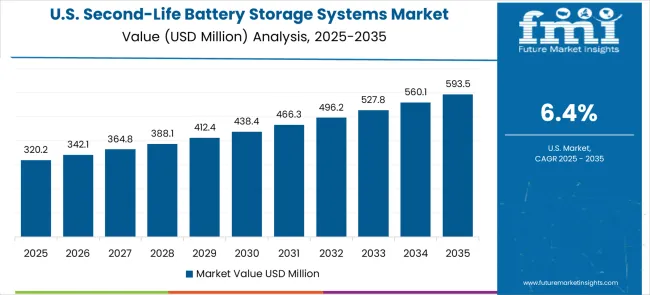
The second-life battery storage systems market in the USA is expanding at a CAGR of 6.4%, driven by established renewable energy industries and growing emphasis on grid modernization enhancement. Large utility companies and energy storage providers are implementing comprehensive second-life battery capabilities to serve diverse grid stabilization requirements. The market benefits from established energy storage distribution networks and professional development programs that support various renewable energy applications.
Energy industry leadership is enabling standardized storage utilization across multiple grid types, providing consistent sustainability standards and comprehensive energy storage coverage throughout regional markets. Professional development and certification programs are building specialized technical expertise among energy personnel, enabling effective second-life battery utilization that supports evolving renewable energy facility requirements.
The second-life battery storage systems market in the UK is projected to grow at a CAGR of 5.7%, supported by established renewable energy sectors and growing emphasis on sustainability capabilities. British energy facilities and utility service providers are implementing second-life battery systems that meet industry environmental standards and operational requirements. The market benefits from established renewable energy infrastructure and comprehensive training programs for energy professionals.
Energy facility investments are prioritizing sustainable storage solutions that support diverse renewable applications while maintaining established environmental and performance standards. Professional development programs are building technical expertise among energy personnel, enabling specialized second-life battery operation capabilities that meet evolving facility requirements and sustainability standards.
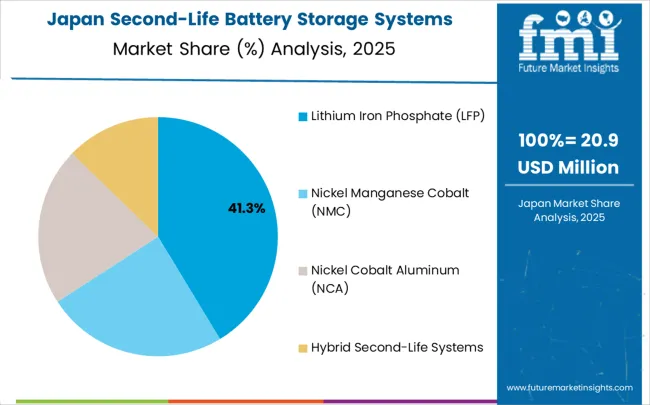
The second-life battery storage systems market in Japan is growing at a CAGR of 5%, driven by the country's focus on energy technology innovation and circular economy enhancement applications. Japanese energy facilities are implementing advanced second-life storage systems that demonstrate superior performance reliability and environmental consistency. The market is characterized by emphasis on technological excellence, quality assurance, and integration with established renewable energy workflows.
Energy technology investments are prioritizing innovative storage solutions that combine advanced second-life battery technology with precision energy management while maintaining Japanese quality and reliability standards. Professional development programs are ensuring comprehensive technical expertise among energy personnel, enabling specialized storage capabilities that support diverse renewable energy applications and facility requirements.
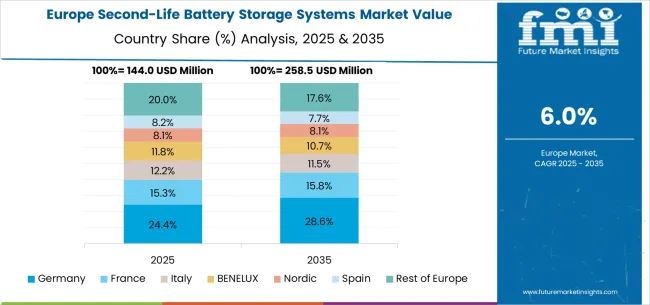
The second-life battery storage systems market in Europe is forecast to expand from USD 158.8 million in 2025 to USD 304.1 million by 2035, registering a CAGR of 6.7%. Germany will remain the largest market, holding 30.4% share in 2025, easing to 29.8% by 2035, supported by strong renewable energy infrastructure and advanced sustainability standards. The United Kingdom follows, rising from 22.5% in 2025 to 23% by 2035, driven by renewable energy facility modernization and circular economy initiatives. France is expected to maintain stability from 17.2% to 16.9%, reflecting consistent renewable energy industry investments and sustainability requirements. Italy holds around 13.1% throughout the forecast period, supported by renewable energy facility upgrades and sustainable storage system modernization programs. Spain grows from 9.6% to 10.2% with expanding renewable energy infrastructure and increased focus on second-life battery storage solutions. BENELUX markets maintain 4.8% to 4.6%, while the remainder of Europe hovers near 2.4%--2.5%, balancing emerging Eastern European renewable energy development against mature Nordic markets with established circular economy adoption patterns.
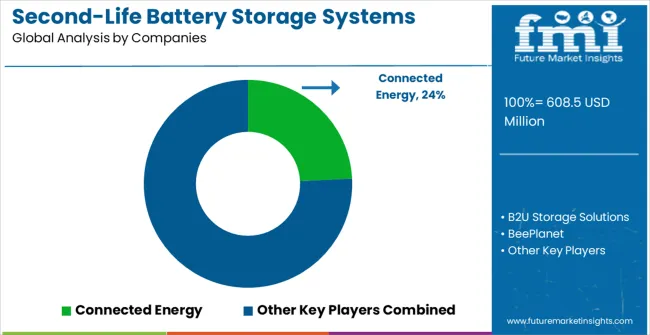
The Second-Life Battery Storage Systems market is defined by competition among specialized battery recycling companies, energy storage system manufacturers, and circular economy solution providers. Companies are investing in advanced battery refurbishment technology development, performance validation, sustainability optimization, and comprehensive lifecycle service capabilities to deliver reliable, cost-effective, and environmentally-friendly energy storage solutions. Strategic partnerships, technological innovation, and sustainability expertise are central to strengthening product portfolios and market presence.
Connected Energy offers comprehensive second-life battery solutions with established recycling expertise and professional-grade energy storage capabilities. B2U Storage Solutions provides specialized battery refurbishment services with focus on performance reliability and grid integration. BeePlanet delivers advanced circular economy solutions with emphasis on sustainability and cost-effective operation. Element Energy specializes in energy storage systems with advanced battery lifecycle technology integration.
Redwood Materials offers professional-grade battery recycling with comprehensive sustainability support capabilities. Tesla Energy delivers established energy storage solutions with advanced second-life battery technologies. CATL provides specialized battery systems with focus on performance optimization. Sonnen, Enphase Energy, Form Energy, LG Energy, Panasonic, BYD, and Relectrify offer specialized manufacturing expertise, sustainability reliability, and comprehensive development across global and regional energy storage market segments.
| Item | Value |
|---|---|
| Quantitative Units | USD 608.5 million |
| Battery Chemistry | Lithium Iron Phosphate (LFP), Nickel Manganese Cobalt (NMC), Nickel Cobalt Aluminum (NCA), Hybrid Second-Life Systems |
| Application | Residential, Commercial, Utility-Scale |
| Regions Covered | North America, Europe, East Asia, South Asia & Pacific, Latin America, Middle East & Africa |
| Country Covered | China, India, Germany, Brazil, United States, United Kingdom, Japan, and 40+ countries |
| Key Companies Profiled | Connected Energy, B2U Storage Solutions, BeePlanet, Element Energy, Redwood Materials, Tesla Energy, CATL, Sonnen, Enphase Energy, Form Energy, LG Energy, Panasonic, BYD, Relectrify |
| Additional Attributes | Dollar sales by battery chemistry and application segment, regional demand trends across major markets, competitive landscape with established battery recycling manufacturers and emerging circular economy providers, customer preferences for different chemistry options and sustainability features, integration with renewable energy systems and grid storage protocols, innovations in battery refurbishment efficiency and performance validation technologies, and adoption of circular economy design features with enhanced sustainability capabilities for improved energy storage workflows. |
The global second-life battery storage systems market is estimated to be valued at USD 608.5 million in 2025.
The market size for the second-life battery storage systems market is projected to reach USD 1,163.8 million by 2035.
The second-life battery storage systems market is expected to grow at a 6.7% CAGR between 2025 and 2035.
The key product types in second-life battery storage systems market are lithium iron phosphate (lfp), nickel manganese cobalt (nmc), nickel cobalt aluminum (nca) and hybrid second-life systems.
In terms of application, residential segment to command 0.0% share in the second-life battery storage systems market in 2025.






Our Research Products

The "Full Research Suite" delivers actionable market intel, deep dives on markets or technologies, so clients act faster, cut risk, and unlock growth.

The Leaderboard benchmarks and ranks top vendors, classifying them as Established Leaders, Leading Challengers, or Disruptors & Challengers.

Locates where complements amplify value and substitutes erode it, forecasting net impact by horizon

We deliver granular, decision-grade intel: market sizing, 5-year forecasts, pricing, adoption, usage, revenue, and operational KPIs—plus competitor tracking, regulation, and value chains—across 60 countries broadly.

Spot the shifts before they hit your P&L. We track inflection points, adoption curves, pricing moves, and ecosystem plays to show where demand is heading, why it is changing, and what to do next across high-growth markets and disruptive tech

Real-time reads of user behavior. We track shifting priorities, perceptions of today’s and next-gen services, and provider experience, then pace how fast tech moves from trial to adoption, blending buyer, consumer, and channel inputs with social signals (#WhySwitch, #UX).

Partner with our analyst team to build a custom report designed around your business priorities. From analysing market trends to assessing competitors or crafting bespoke datasets, we tailor insights to your needs.
Supplier Intelligence
Discovery & Profiling
Capacity & Footprint
Performance & Risk
Compliance & Governance
Commercial Readiness
Who Supplies Whom
Scorecards & Shortlists
Playbooks & Docs
Category Intelligence
Definition & Scope
Demand & Use Cases
Cost Drivers
Market Structure
Supply Chain Map
Trade & Policy
Operating Norms
Deliverables
Buyer Intelligence
Account Basics
Spend & Scope
Procurement Model
Vendor Requirements
Terms & Policies
Entry Strategy
Pain Points & Triggers
Outputs
Pricing Analysis
Benchmarks
Trends
Should-Cost
Indexation
Landed Cost
Commercial Terms
Deliverables
Brand Analysis
Positioning & Value Prop
Share & Presence
Customer Evidence
Go-to-Market
Digital & Reputation
Compliance & Trust
KPIs & Gaps
Outputs
Full Research Suite comprises of:
Market outlook & trends analysis
Interviews & case studies
Strategic recommendations
Vendor profiles & capabilities analysis
5-year forecasts
8 regions and 60+ country-level data splits
Market segment data splits
12 months of continuous data updates
DELIVERED AS:
PDF EXCEL ONLINE
Battery Operated Light Market Forecast and Outlook 2025 to 2035
Battery Voltage Recorder Market Size and Share Forecast Outlook 2025 to 2035
Battery Resistance Tester Market Size and Share Forecast Outlook 2025 to 2035
Battery Technology Market Size and Share Forecast Outlook 2025 to 2035
Battery Electric Vehicle (BEV) Market Size and Share Forecast Outlook 2025 to 2035
Battery Separator Paper Market Size and Share Forecast Outlook 2025 to 2035
Battery Cyclers Market Size and Share Forecast Outlook 2025 to 2035
Battery Voltage Supervisor Market Size and Share Forecast Outlook 2025 to 2035
Battery Platforms Market Analysis Size and Share Forecast Outlook 2025 to 2035
Battery Management System Market Report – Growth & Forecast 2025-2035
Battery Binders Market Size and Share Forecast Outlook 2025 to 2035
Battery Materials Recycling Market Size and Share Forecast Outlook 2025 to 2035
Battery Packaging Material Market Size and Share Forecast Outlook 2025 to 2035
Battery Materials Market: Growth, Trends, and Future Opportunities
Battery Electrolytes Market Analysis & Forecast by Type, End-Use, and Region through 2035
Battery Testing Equipment Market Growth – Trends & Forecast 2025 to 2035
Battery Swapping Charging Infrastructure Market Trends and Forecast 2025 to 2035
Battery Leasing Service Market Analysis & Forecast by Business Model, Battery Type, Vehicle Type, and Region Through 2025 to 2035
Battery-Free Sensors Market Insights - Trends & Forecast 2025 to 2035
Competitive Breakdown of Battery Management System Providers

Thank you!
You will receive an email from our Business Development Manager. Please be sure to check your SPAM/JUNK folder too.
Chat With
MaRIA